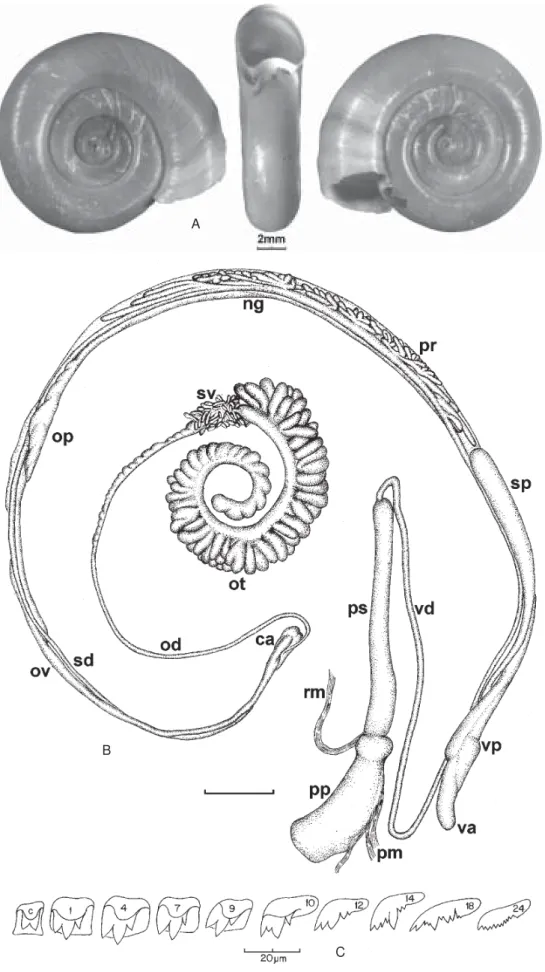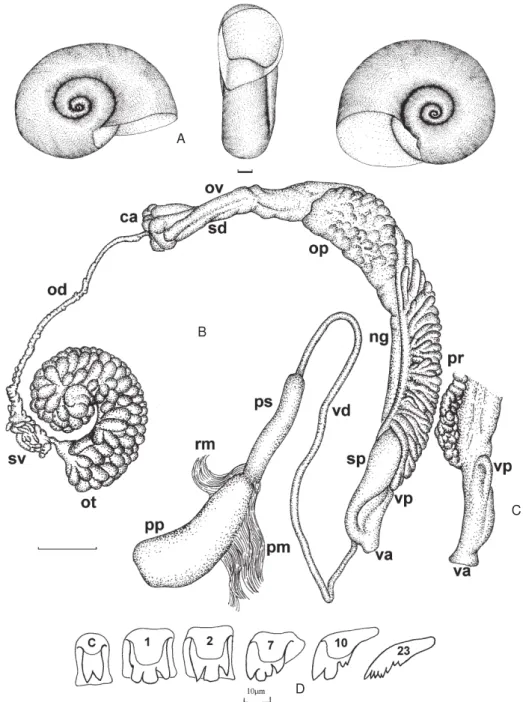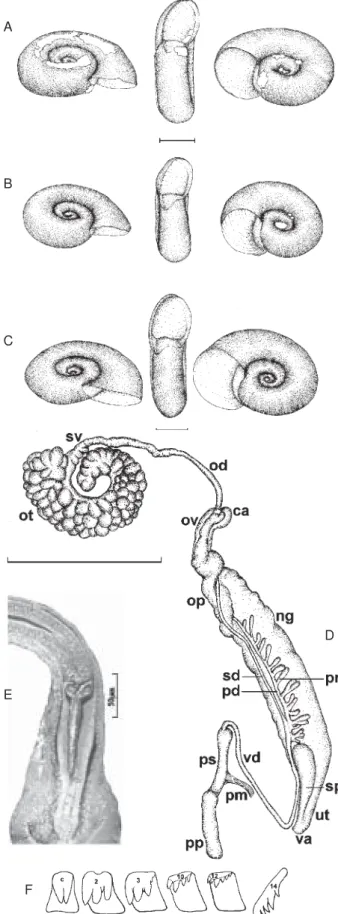357 357 357 357 357 Mem Inst Oswaldo Cruz, Rio de Janeiro, Vol. 99(4): 357-362, June 2004
Planorbidae, Lymnaeidae and Physidae of Ecuador
(M ollusca: Basommatophora)
W Lobato Paraense
Departamento de Malacologia, Instituto Oswaldo Cruz-Fiocruz, Av. Brasil 4365, 21045-900 Rio de Janeiro, RJ, Brasil
In the course of a trip to Ecuador I had the opportunity of collecting topotypic specimens of the following nominal species of pulmonate molluscs: Biomphalaria cousini Paraense, 1966; Planorbis equatorius Cousin, 1887; P. canonicus Cousin, 1887; Lymnaea cousini Jousseaume, 1887 and P. boetzkesi Miller, 1879. Additional findings were: Helisoma trivolvis (Say, 1817), Biomphalaria peregrina (Orbigny 1835), Drepanotrema anatinum (Orbigny, 1835), D. kermatoides (Orbigny, 1835), D. lucidum (Pfeiffer, 1839), D. surinamense (Clessin, 1884), Lymnaea col-umella Say, 1817 and Physa acuta Draparnaud, 1805.
P. boetzkesi and P. canonicus are considered junior synonyms of Gyraulus hindsianus (Dunker, 1848) and Biomphalaria peregrina (Orbigny, 1835), respectively.
Key words: Biomphalaria cousini - B. equatoria -B. peregrina - Drepanotrema anatinum - D. kermatoides - D. lucidum - D. surinamense - Gyraulus hindsianus - Helisoma trivolvis - Lymnaea columella - Lymnaea cousini - Physa acuta -Planorbis
canonicus - P. boetzkesi - synonymy - Ecuador
The snails dealt with in this paper were collected by myself during a trip to Ecuador, supported by the Pan American Health Organization, in April 1965. A review of the malacological literature concerning that country shows that so far no species of the families Planorbidae, Lymnaeidae, and Physidae were recorded there besides those mentioned here.
METHODS
Since when this work was performed I used no relax-ing agents, the followrelax-ing protocol was adopted. A speci-men freely moving about, with the head and foot well exposed, is carefully picked up with a forceps, so as to prevent it from retracting back to the shell. The shell aper-ture is kept upwards, and the snail is gradually plunged into hot water at 70oC for about 30 sec, the time varying with the animal’s size. If the shell is plunged to the level of the aperture for the first 15 sec the animal usually does not retract and then, after being completely submerged, will die. The dead animal is plunged into cold water and gently pulled by the head-foot with a small forceps, so as to disconnect the insertion of the columellar muscle. The whole animal is then drawn out of the shell, which re-mains unbroken and filled with water, which dilutes the blood residuum avoiding its putrefaction within the shell. The animal is fixed in Railliet-Henry’s fluid modified for freshwater specimens (distilled water 930 ml, sodium chlo-ride 6 g, formalin 50 ml, glacial acetic acid 20 ml), where it must remain for at least 24 h before dissection. One change of the fixative after the first 24 h is advisable. The amount of fluid should not be less than 10 times the volume of
material to be fixed. In small species (of Drepanotrema and Gyraulus)the animal is easily broken when attempts are made to pull it from the shell. In such cases the whole specimen (animal with the shell) should be placed in the fixative after immersion in hot water; owing to CO2 pro-duction the fixative should be changed several times to avoid unstopping of the vial under gas pressure. The radulae are separated from the buccal mass by digestion in a vial with 10% NaOH (left overnignt in the incubator at 56 C). They are then rinsed in tap water and mounted in a drop of glycerin on a microscopic slide, with the dorsal (toothed) side upwards as in the living animal.
Voucher specimens (register number in parentheses) are deposited in the Malacological Collection of Instituto Oswaldo Cruz.
Genus Helisoma Swainson, 1840
Helisoma trivolvis (Say, 1817a) - Pond between Guayaquil and Pascuales (1122). Studied by Paraense (1976) as senior synonym of Planorbis equatorius Cousin, 1887. As seen below, P. equatorius Cousin is re-ally a Biomphalaria.
Genus Biomphalaria Preston, 1910
Biomphalaria cousini Paraense, 1966 - Brook flowing into the river Pobe, Santo Domingo de los Colorados (1105). Shell and anatomy as in Paraense (1966a).
Biomphalaria equatoria (Cousin, 1887) - Original de-scription:
5. Planorbis Equatorius. Pl. IV, fig. 8.
Coquille orbiculaire fortement déprimée et très légèrement ombiliquée sur les deux faces. Son test assez solide, érodé par place, peu luisant et à peine transpar-ent, est orné à la surface de stries d’accroissement assez régulières, très fines, serrées et saillantes que l’on ne voit nettement qu’aidé d’un verre grossissant. Sa couleur est d’un corné fauve jaunâtre. Sa spire est formée de 5 tours ½ irrégulièrement arrondis et un peu déprimés sur Fax: +55-21-2280.5840. E-mail: paraense@ioc.fiocruz.br
358 358 358 358
358 Planorbidae, Lym naeidae and Physidae of Ecuador • W Lobato Paraense
le côté gauche, de sorte que la face droite de la coquille paraît plus large. Les tours, séparés sur les deux faces par une suture large et profonde, se développent d’une façon lente et régulière,excepté le dernier qui se dilate en approchant du péristome.
L’ouverture a la forme d’un ovale découpé à son extrémité interne par l’avant-dernier tour qui est recouvert d’un enduit blanchâtre qui relie en-dehors les deux extrémités du péristome, dont les bords sont simples, assez minces et tranchants. Le bord droit, à sa naissance, dépasse le bord opposé de 2 millimètres environ.
Dimensions: gr. diam., 20mm; pet. diam., 17mm; épaisseur, 6mm5.
Hab. – Équateur.
In the Jijón y Caamaño Library (Quito) there is a copy of Cousin’s paper annotated by himself as follows: “5. Planorbis AEquatorius – 78 – Hab. Environs de Guayaquil, Équateur. Mapasinga-Macare.”
The present sample (1109, Fig. 1) was collected from a pond between Guayaquil and Pascuales, about 5 km from the former, together with Helisoma trivolvis (see above). The largest specimen (Fig. 1A) is 18 mm in shell diameter and answers to Cousin’s description.
The renal region shows no special characteristics. The reproductive system (Fig. 1B) was observed in 20 dissected specimens.
The ovotestis is composed of about 80 chiefly un-branched diverticula. Of 88 units in a specimen, 70 were simple, 11 bifurcate, 6 trifurcate and 1 quadrifid. Another specimen had 81 diverticula, 65 unbranched, 14 bifurcate and 2 trifurcate. The seminal vesicles are very thin and closely packed. The carrefour, the oviduct and the ovidu-cal pouch, the nidamental gland and the uterus show no special features.The vagina is very short, with a small well-defined vaginal pouch. The spermatheca is unusu-ally long, club-shaped, its body merging very graduunusu-ally into the elongate duct. The prostate has about 10 diver-ticula; they split early into primary divisions which soon give rise to short secondary and tertiary subdivisions. The foremost and the caudal diverticula send out longer primary branches, and the intermediate ones interlace into a net-like arrangement. The distal half of the vas deferens is distinctly narrower than the penis sheath. The latter is usually twice as long as the prepuce.
The radula is represented in Fig. 1C.
Additional specimens of B. equatoria were collected from a drainage ditch at Nobol (1089), a pond at Pascuales (1117), a rice paddy at Santa Lucia (1125) and a marsh at Carmelo, Isla Puná (1127).
Biomphalaria peregrina (Orbigny, 1835) - Swamp at Chillogallo, near Quito (1104). Studied by Paraense (1966b). Susceptible to infection with Schistosoma mansoni (see Paraense & Corrêa 1973).
Planorbis canonicus Cousin, 1887 - Original descrip-tion:
6. Planorbis canonicus. Pl. IV, fig. 11.
Coquille orbiculaire à tours arrondis, dont la face gauche, plus étroite, est plus largement et plus profondément
ombiliquée; son test, mince, fragile, transparent, est peu luisante et légèrement hispide à la surface. A la loupe, on découvre des stries d’accroissement très fines, serrées et peu régulières. Sa couleur est d’un corné jaune-verdâtre très clair; la spire est formée de 3 tours ½ que l’on ne distingue nettement que sur la face gauche; il se développe d’une façon régulière et rapide. La suture qui les separe est assez large et très nettement accusée. L’ouverture, oblique et circulaire, est échancrée en dedans par l’avant-dernier tour, qui est recouvert d’une couche d’enduit dont le bord externe relie entre eux les deux extrémités du péristome, qui s’infléchissent l’une vers l’autre et viennent se fixer sur les parties latérales de la périphérie de l’avant-dernier tour. Le péristome, dont le bord droit dépasse de beaucoup celui du côté opposé, est droit, mince et tranchant; la courbe qu’il décrit est presque circulaire.
Dimensions: gr. diam., 10mm; pet. diam., 8mm; épaisseur, 4mm.
Hab. – J’ai recueilli cette espèce dans le lac Saint-Paolo, près Quito, ou elle est très abondante.
About 250 specimens were collected from lake San Pablo (1093), most of which were heavily infested with trematodes. In shell and anatomy (Fig. 2A, B, C, D) they are indistinguishable from Biomphalaria peregrina (see Paraense 1966b).
A planorbid from the environs of Guayaquil, identified as Armigerus philippianus (Dunker) by Dr. JP E Morrison (US National Museum), and studied by Barbosa et al. (1958a) as Tropicorbis philippianus, is anatomically in-distinguishable from B. peregrina. By the way, B. peregrina is referred by Orbigny (1835) to Guayaquil, and Planorbis philippianus by Dunker (1848) to “Cochabambâ in Bolivia”.
Genus Drepanotrema Fischer & Crosse, 1880 Drepanotrema anatinum (Orbigny, 1835) - Ponds at Santa Lucia (1123). Shell and anatomy as in Paraense & Deslandes (1956a).
Drepanotrema kermatoides (Orbigny, 1835) - Drain-ing ditch at Nobol (1088), with D. surinamense; pond between Guayaquil and Pascuales (1121), with D. lucidum. Shell and anatomy as in Paraense & Deslandes (1958).
Drepanotrema lucidum (Pfeiffer, 1839) - Abundant in pond at Lomas de Sargentillo, between Guayaquil and Pascuales (1101). Shell and anatomy as in Paraense & Deslandes (1956b), as D. melleum.
Drepanotrema surinamense (Clessin, 1884) - Drain-ing ditch at Nobol (1090) with D. kermatoides. Shell and anatomy as in Paraense & Deslandes (1960).
Genus Gyraulus “Agassiz” Charpentier, 1837 Gyraulus hindsianus (Dunker, 1848) - Original descrip-tion:
6. Planorbis Hindsianus, Dkr. Pl. testâ parvulâ, cornea, subviridescente, tenuissimè confertimque striatâ, diaphanâ, subnitidâ, suprà planiusculâ, medio impressâ, infrà umbilicatâ; anfractibus tribus ovatis; aperturâ obliquâ. Species magnitudine ferè praecedentis [diam. max. 1 ½’”; alt. ½’”] sed colore et striis spiralibus deficientibus satis diversa.
359 359 359 359 359 Mem Inst Oswaldo Cruz, Rio de Janeiro, Vol. 99(4), June 2004
Fig. 1: Biomphalaria equatoria - A: shell; B: reproductive system; C: radular teeth (c = central; 1, 4, 7, 9 = laterals; 10, 12, 14 =
intermediates; 18, 24 = marginals). Bar = 1mm (unless otherwise stated). A
B
360 360 360 360
360 Planorbidae, Lym naeidae and Physidae of Ecuador • W Lobato Paraense
Fig. 2: Planorbis canonicus (= Biomphalaria peregrina) - A: shell; B: reproductive system; C: cephalic end of female duct; D: radular teeth
(c = central; 1, 2 = laterals; 7, 10 = intermediates; 23 = marginal). Bar = 1 mm (unless otherwise stated). Abundant in a swamp at Hacienda San Roque, on lake
San Pablo (1094), and in a brook at Cumbayá, a rural dis-trict of Quito (1097). Its anatomic features are shown in Fig. 3.
The renal region shows no special characteristics. The ovotestis is composed of about 30-60 pear-shaped, chiefly unbranched diverticula. Differently from species of Biomphalaria, it is not partly covered by the digestive gland, which is situated between it and the carrefour. The seminal vesicles are poorly developed. The carrefour, oviduct, nidamental gland, uterus and vagina show no special characteristics. The spermatheca is club-shaped, its body gradually narrowing into the duct and opening into a short vagina. The prostate has about 20
diverticula, mostly unbranched, less frequently bifurcate. The distal half of the vas deferens is distinctly narrower than the penis sheath. The latter is usually as long as the prepuce. The penial stylet is scissors-like in appearance. Planorbis boetzkesi Miller, 1879 - Original descrip-tion:
2. Planorbis (Subg. Gyraulus Agass.) Boetzkesi n. sp. – Taf. VII. Fig. 4. a. A-C.
Testa planulata, cornea vel nigra, tenuis, minutissime undato-vel punctato-striata, superne convexa, spira parum immersa, inferne late umbilicata; anfractus 31/
4 (ad summum 31/
2) celeriter accrescentes, sutura pro-funda disjuncti, superne oblique compressi, infra rotundati; apertura obliqua, oblique elliptica; marginibus
A
B
C
361 361 361 361 361 Mem Inst Oswaldo Cruz, Rio de Janeiro, Vol. 99(4), June 2004
Fig. 3: Gyraulus hindsianus - A, B: syntypes from Natural History Museum, London; C: shell from lake San Pablo; D: reproductive system; E: confocal image of penis inside penis sheath, showing stylet; F: radular teeth (c = central; 2, 3 = laterals; 10, 12 = interme-diates; 14 = marginal). Bar = 1 mm (unless otherwise stated). A
B
D
E
F C
acutis, callo crasso junctis, margine basali parum dilatato. Diam. maj. 3, min. 21/
2, alt. 3/4 mm. Hab. Chillo, Rio S. Pedro, cum praecedenti [Planorbis pedrinus, see be-low] crebrior (P. Boetzkes legit).
Numerous specimens were collected from a brook af-fluent of river San Pedro. In shell and anatomy this nomi-nal species is indistinguishable from Gyraulus hindsianus.
Genus Physa Draparnaud, 1801
Physa acuta Draparnaud, 1805 - Brook tributary of the San Pedro river, environs of Quito (1113). As shown by Paraense & Pointier (2003), Physa acuta is senior syn-onym of P. cubensis Pfeiffer, 1839.
Genus Lymnaea Lamarck, 1799
Lymnaea cousini Jousseaume, 1887 - Topotypes from Chanchu-Yacu, near Quito (1112), studied by Paraense (1995). Additional specimens from lake San Pablo (1095). Lymnaea columella Say, 1817b - Pond at Nobol (1091). Shell and anatomy as in Paraense (1983).
REMARKS
- Planorbis pedrinus Miller, 1879, collected by Boetzkestogether with P. boetzkesi, was not found in this survey.
- The following nominal species were not collected owing to failure to visit their localities: Lymnaea raphaelis Jousseaume, 1887 (Cuenca); Aplecta carolita Jouseaume, 1887 (San Nicolas); Aplecta gualbertoi Cousin, 1887 (Mapasingue).
- Australorbis sericeus (Dunker, 1848) – Described originally by Dunker as Planorbis sericeus from unknown Fig. 4: localities mentioned in the text: ! searched by the author;
362 362 362 362
362 Planorbidae, Lym naeidae and Physidae of Ecuador • W Lobato Paraense
locality (“Patria ignota”), was collected at Los Rios, Ecua-dor, by Dr. JD Rodrigues, and studied by Barbosa, Barbosa and Carneiro (1963).
ACKNOWLEDGEMENTS
To Mr Fred Naggs of the Department of Zoology, Natural History Museum, London, for the loan of specimens of Planor-bis hindsianus,to the technologist JE Prado for the preparation of figures, and to Dr Henrique L Lenzi and Thiago B Branquinho (Department of Pathology) for the image of Fig. 3E.
ABBREVIATIONS IN FIGURES
ca: carrefour; ng: nidamental gland; od: ovispermiduct; op: oviducal pouch; ot: ovotestis; ov: oviduct; pd: prostate duct; pm: protractor muscle; pp: prepuce; pr: prostate; ps: penis sheath; rm: retractor muscle; sd: spermiduct; sp: spermatheca; sv: seminal vesicles; ut: uterus; va: vagina; vd: vas deferens; vp: vaginal pouch
REFERENCES
Barbosa FS, Barbosa I, Carneiro E 1958a. The anatomy of Tropicorbis philippianus (Dunker) and its relationships to the Brazilian Planorbidae (Mollusca, Pulmonata). J Conchyliol 97: 180-185.
Barbosa FS, Barbosa I, Rodríguez JD 1958b. Tropicorbis philippianus (Dunker) a potential intermediate host of Schis-tosoma mansoni in Ecuador. J Parasitol 44: 622.
Barbosa FS, Barbosa I, Carneiro E 1963. Description of Australorbis sericeus (Dunker), a possible intermediate host of Schistosoma mansoni in Ecuador. An Trop Med Parasit 57: 52-58.
Clessin S 1884. Die Familie der Limnaeiden enthaltend die genera Planorbis, Limnaeus, Physa und Amphipeplea. In Martini & Chemnitz, Systematisches Conchylien-Cabinet 17, Bauer & Raspe, Nürnberg.
Cousin A 1887. Faune malacologique de la Republique de l’Équateur. Bull Soc Zool France 12: 187-287.
Draparnaud JPR 1805. Histoire Naturelle des Mollusques Terrestres et Fluviatiles de la France,D Colas, Paris. Dunker W 1848. Diagnoses specierum novarum generis
Plan-orbis collectionis Cumingianae. Proc Zool Soc London 16: 40-43.
Jousseaume F 1887. Mollusques nouveaux de la République de l’Équateur. Bull Soc Zool France 12: 165-186.
Miller K 1879. Die Binnenmollusken von Ecuador. Malakozool
Blät 1: 117-203.
Orbigny A 1835. Synopsis terrestrium et fluviatilium molluscorum, in suo per Americam Meridionalem itinere, ab A. D’Orbigny, collectorum. Mag Zool 5, Classe 5 (61-62): 1-44.
Paraense WL 1966a. Biomphalaria amazonica and B. cousini, two new species of Neotropical planorbid molluscs. Rev Brasil Biol 26: 115-126.
Paraense WL 1966b.The synonymy and distribution of Biomphalaria peregrina in the Neotropical region. Rev Brasil Biol 26: 269-296.
Paraense WL 1976. Helisoma trivolvis and some of its syn-onyms in the Neotropical region (Mollusca: Planorbidae). Rev Brasil Biol 36: 187-204.
Paraense WL 1983. Lymnaea columella in Northern Brazil. Mem Inst Oswaldo Cruz 78: 477-482.
Paraense WL 1995. Lymnaea cousini Jousseaume, 1887, from Ecuador (Gastropoda: Lymnaeidae). Mem Inst Oswaldo Cruz90: 605-609.
Paraense WL, Corrêa LR 1973. Susceptibility of Biomphalaria peregrina from Brazil and Ecuador to two strains of Schis-tosoma mansoni. Rev Inst Med Trop São Paulo 15: 127-130.
Paraense WL, Deslandes N 1956a. The Brazilian species of Drepanotrema. I. D. anatinum (Orbigny, 1835). Rev Brasil Biol 16: 491-499.
Paraense WL, Deslandes N 1956b. The Brazilian species of Drepanotrema. II. D. melleum (Lutz, 1918). Rev Brasil Biol 16: 527-534.
Paraense WL, Deslandes N 1958. The Brazilian species of Drepanotrema. VI. D. kermatoides (Orbigny, 1835). Rev Brasil Biol 18: 293-299.
Paraense WL, Deslandes N 1960. Drepanotrema surinamense, with an addendum on D. petricola (Planorbidae). Rev Brasil Biol 20: 257-263.
Paraense WL, Pointier JP 2003. Physa acuta Draparnaud, 1805 (Gastropoda: Physidae): a study of topotypic speci-mens. Mem Inst Oswaldo Cruz 98:513-517.
Pfeiffer L 1839. Bericht über die Ergebnisse meiner Reise nach Cuba im Winter 1838-1839. Arch Naturg 5: 346-358. Say T 1817a. Article “Conchology”. American edition of
Nicholson’s Encyclopedia of Arts and Sciences 2, Philadel-phia.


